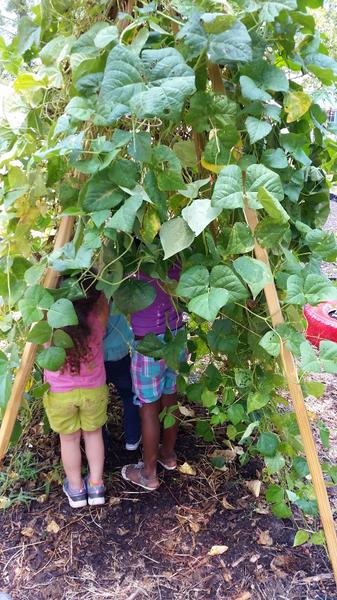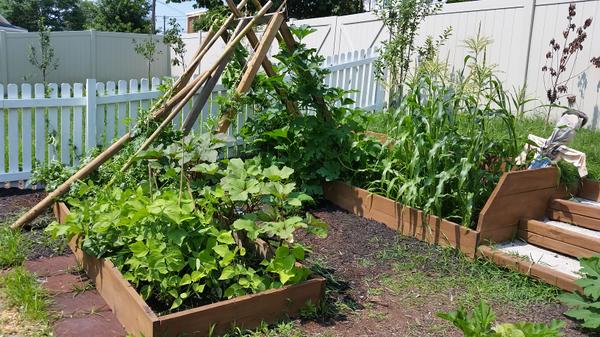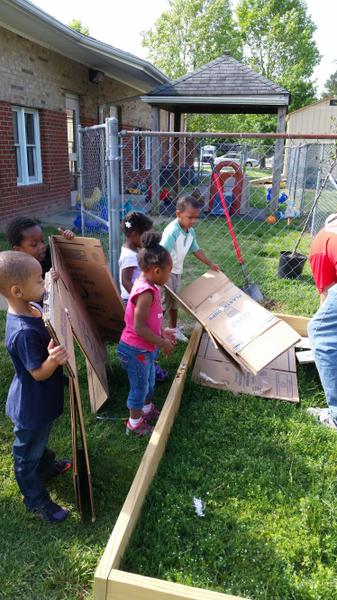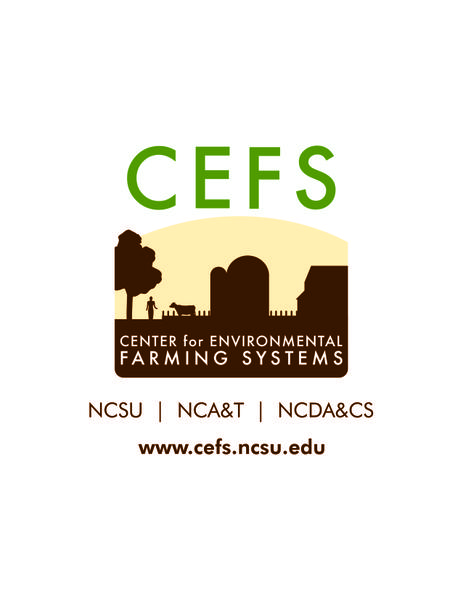This publication focuses on developing fruit and vegetable production gardens in the Outdoor Learning Environment (OLE) of childcare centers. Included are basic garden design and layout to help childcare centers get started in year-round gardening activities. This is the second of fifteen publications about childcare center production gardens.
Outdoor Learning Environment (OLE) is the term used for the licensed outdoor space of childcare centers in the North Carolina Childcare Center Licensing Rules. The Natural Learning Initiative (NLI) considers design of the OLE as a preventive health intervention to support children’s healthy development, including increased physical activity and adoption of healthy eating habits.
Settings where children and teachers can engage in hands-on fruit and vegetable gardening are an essential best-practice indicator of a high quality OLE.1 Gardening with children provides numerous opportunities for building the science skills of observation, inquiry, and experimentation. When children participate in growing their own food, they are more motivated to taste, eat, and enjoy the produce resulting from their efforts. Gardening also helps children build an understanding of and respect for nature and our environment.
With some planning a garden can be designed and installed to suit the needs of the children and teachers, providing endless opportunities to enrich the learning environment. Dream big, start small, and have fun!
Location Considerations
The most important considerations when locating your fruit and vegetable production garden are:
Sunlight:
- Observe which areas of the OLE receive sun at different times of the year, and check present sun patterns with children for a few days. Which area gets the most afternoon sun? A vegetable garden will do best in an area that receives full sun for most of the day.
Access:
- Pick an area that is easily accessible from the center building. Closeness makes it easier to pay attention to weeds, insect pests, watering needs, and ripening vegetables.
Soil:
- Fruit and vegetables require nutrient-rich, well-draining soil. If using an existing planting bed, soil samples can be sent to the NC Department of Agriculture & Consumer Services, Agronomic Division to determine if any amendments are needed.
Level Ground:
- Relatively flat ground makes construction of beds and circulation in and around them easier.
Water:
- Consider proximity to a potable water source; the closer the better.
Optional considerations:
- Use existing structures like a boundary fence. This provides a protected back to garden beds and a vertical surface for vines (such as cucumbers, tomatoes, and beans).
- Provide storage for garden tools and materials. Locate the garden next to existing storage or where new storage can be constructed.
Raised or In-Ground Planting Beds?
The type of garden bed is important when considering layout (a topic that follows below). The two most common garden types are raised beds and in-ground beds. Raised beds are typically wood-framed structures filled with a garden soil blend and are 9 inches to 2 feet tall. In-ground beds are planted directly in the ground. Each alternative has benefits. Raised beds, however, are often preferred in a childcare setting because of these advantages:
Raised Beds:
A taller gardening surface:
- Raised beds offer easier access for both children and teachers.
Managed soil quality:
- A blend of half garden soil and half compost helps to optimize soil fertility and drainage.
Plant protection:
- Defined edges make plants less likely to be trampled by little feet.
Long growing season:
- Soil in raised beds tends to warm up sooner in the spring and allows planting of summer crops a few weeks sooner than in-ground planting beds.
Easy to manage:
- Edges define boundaries between adjacent surfaces like lawn to help prevent grass from spreading into the growing bed.
Timber construction:
- Wood framing allows seating, work surfaces, and storage to be integrated into the garden setting.
In-ground Beds:
Low cost:
- In-ground beds may cost less, but they can require greater investments of time in soil preparation and long-term management.
Spacious:
- An open space is good for sprawling plants, such as sweet potatoes and melons, and for mixing in flowers with fruit and vegetables.
Flexible:
- In-ground beds can be designed as large walk-in gardens. Stepping stone paths allow for a diverse mix of plants in one place. Children and teachers can re-design the garden seasonally by reconfiguring the pathways.
Layout
Once the general location of the garden has been selected, the number, size, and spacing of garden beds can be decided.
Design tips:
- Keep beds narrow so that children can reach the middle of the bed from both sides (no more than 3 to 4 feet wide).
- Space garden beds far enough apart to allow room for children to walk between them (2 to 3 feet is good, 18 inches minimum).
To test the planting bed layout, use spray chalk (available at hardware stores), a garden hose, or a length of rope laid on the ground to mark bed outlines. Or sprinkle flour on the ground in the shape of the beds to ensure the garden bed size and spacing is appropriate for the space.
Raised Planting Bed Construction
Raised planting beds are fairly simple to construct. Use long-lasting materials such as cedar, redwood, composite, or treated lumber. Do not use railroad ties or older, reclaimed treated lumber to construct raised beds, as these materials may contain hazardous chemicals.
Before constructing raised beds, clear existing vegetation from the garden area. Lay sheets of cardboard on the ground at least a week before construction to help kill existing ground cover.
To build a simple timber raised bed 4 feet wide by 8 feet long and 10 inches tall, purchase three pieces of dimensioned lumber that are 2 inches × 8 feet × 10 inches. Cut one board in half to create the 4-foot end pieces, and use the remaining 8-foot pieces as the longer sides of the bed. Use 4-inch by 4-inch posts cut to 1-foot lengths set vertically in the corners to help stabilize the beds. Fasten boards at 90 degree angles with galvanized screws.
Fill beds to the top with a blend of half good quality garden soil and half compost (available at garden centers, home improvement centers, or local landscape suppliers).
After planting, top beds with 2 to 3 inches of triple shredded hardwood mulch for weed control and moisture retention.
In-Ground Planting Bed Installation
Design options for in-ground planting beds depend on the shape of the available space. Traditionally, an in-ground garden is either square or rectangular in shape, with pathways laid out in a grid and planting beds between paths. Unless the area has been cultivated before, compacted soil will need to be tilled before planting. Amending the soil with good quality compost will help with drainage and soil fertility. Spread 3 to 6 inches of compost evenly over the garden area, and till to a depth of 6 to 12 inches.
Many of the clay-based soils of North Carolina are more acidic than the optimal growing range. A soil test will determine if lime is needed to raise the pH to an optimal range. Soil testing kits can be obtained from your local Cooperative Extension center. More information can be found at Soil Testing.
To control weeds and lawn grass invasion on pathways, cover the ground surface with recycled burlap coffee sacks, cardboard cut to size, woodchips, or stepping stones.
Year-Round Gardening
In the South, garden space can be maximized to provide year-round gardening and learning opportunities by installing both warm- and cool-season gardens. Refer to other publications in the Local Foods series for additional Information. Growing Warm-Season Fruits and Vegetables in Childcare Production Gardens (LF-007-03) and Growing Cool-Season Vegetables in Childcare Production Gardens (LF-007-04) provide lists of warm- and cool-season vegetables, growing recommendations, and planting dates. Snacking and Cooking with Warm-Season Produce from Childcare Production Gardens (LF-007-05) and Snacking and Cooking with Cool-Season Produce from Childcare Production Gardens (LF-007-06) offer child-friendly recipes describing how to prepare and cook OLE garden produce.
For those living in other US Department of Agriculture regions, contact your local Cooperative Extension agent or nurseries for guidance on planting choices for your region.
References
1 Natural Learning Initiative. 2014. Outdoor Learning Environment Toolkit. College of Design, NC State University.
Local Foods Publication Series Editor
Hannah Dankbar, Manager
Local Foods Program
NC State Extension
Childcare Center Production Gardens Publication Editors
Robin C. Moore, Director
Natural Learning Initiative (NLI)
NC State College of Design
With the NLI Early Childhood Gardening Team:
Nilda Cosco
Sarah Konradi
Mary Archer
Caroline Asher
Karli Stephenson, Graphic Designer
Acknowledgments
Funding for this publication was provided in part by the John Rex Endowment.
The authors wish to express appreciation to Chris Gunter, Nichole Huff, Susan Jakes, Joanna Lelekacs, Debra Ireland, and Barbara Scott for their assistance in preparing this publication.
About the Local Foods Series: Childcare Center Production Gardens
This publication in the Local Foods series is the second of fifteen publications about childcare center production gardens:
- Growing and Cooking Fruits and Vegetables at Childcare Centers (LF-007-01)
- Creating Childcare Center Production Gardens (LF-007-02)
- Growing Warm-Season Fruits and Vegetables in Childcare Production Gardens (LF-007-03)
- Growing Cool-Season Vegetables in Childcare Production Gardens (LF-007-04)
- Snacking and Cooking with Warm-Season Produce from Childcare Production Gardens (LF-007-05)
- Snacking and Cooking with Cool-Season Produce from Childcare Production Gardens (LF-007-06)
- Composting in Childcare Center Production Gardens (LF-007-07)
- Vermicomposting in the Childcare Center Production Gardens (LF-007-08)
- Introducing Children to Insects in Childcare Center Gardens (LF-007-09)
- Easy Fruits to Grow at Childcare Center Gardens (LF-007-10)
- Growing Strawberries in Childcare Center Gardens (LF-007-11)
- Managing Weeds in Childcare Center Gardens (LF-007-12)
- Growing Fruit Trees in Childcare Center Gardens (LF-007-13)
- Growing Muscadines in Childcare Center Gardens (LF-007-14)
- Growing Blueberries in Childcare Center Gardens (LF-007-15)
Publication date: Sept. 16, 2015
Revised: July 1, 2022
LF-007-02
N.C. Cooperative Extension prohibits discrimination and harassment regardless of age, color, disability, family and marital status, gender identity, national origin, political beliefs, race, religion, sex (including pregnancy), sexual orientation and veteran status.








